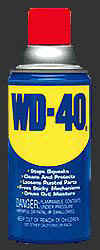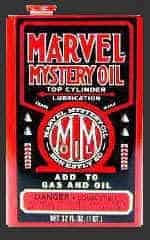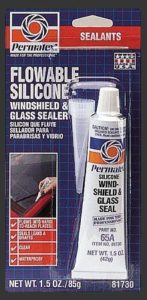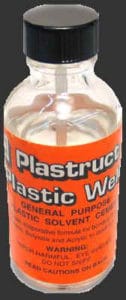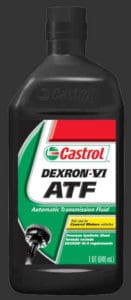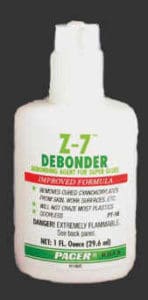A wide variety of chemicals and solvents are available for the cleaning and lubrication of slot cars and track. Many of these products can be made from commonly available products found at any good hardware store or pharmacy. If you are racing on a budget, or use large quantities of these materials making your own can be very inexpensive.
Modern slot cars use a preponderance of synthetic plastic compounds for both the chassis and the body. When using any product for the first time, test it in an out of the way place first to make certain it will not harm the plastic itself. This is especially true of the plastic used in injection-molded body shells.
Racing Oil
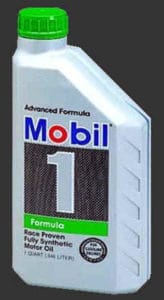
Mobil 1 Synthetic motor oil is an ideal lubricant for slot cars. Purchase or re-use a pin-point oiler and fill it with Mobil 1 to produce your own racing oil.
Mobil 1 synthetic oil is safe to use on plastic bushings as well as sintered bronze oilite bearings. A quart will cost about $5.00 and should last a lifetime. Get the lightest viscosity you can find. There’s even a 5W that you can get at better speed shops and racing centers.
Pin-point oilers are available at most commercial slot car tracks, hobby stores and at Sears.
Lighter Fluid
Commercial lighter fluid has several uses in slot car racing. It can be used to clean and soften rubber tires, as a general purpose cleaner or as a mild solvent to remove the adhesive left behind when stickers are removed.
Lighter fluid is one of the best general purpose cleaners available for slot car racing. Commercial products made by companies such as Ronson and Zippo are simply Naphtha. Check the label for yourself!
Save your next empty container and fill it with Naphtha. The applicator nozzle that comes with the commercial containers is perfect for applying small amounts. Naphtha can be found in the paint department at any good hardware store or building supply house. A gallon will cost around $2.00.
WD-40®
WD-40® aerosol spray can also be used to clean and protect the metal power rails on a slot car track. WD-40 is NOT a lubricant, but rather a water displacement product, hence the WD-40 designation given to it by the Rocket Chemical Company in 1953.
WD-40 works well to protect metal power rails from oxidation and corrosion. WD-40 will however destroy plastic over time, so take care to apply it to the metal power rails only.
WD-40 is available just about everywhere. The best prices however are usually found at large discount stores such as K-Mart or Wal-Mart. It’s also available at most hardware store for slightly more. A large aerosol can will cost approximately $3.00.
Braid Conditioner
Marvel Mystery Oil can also be used to condition both pickup and track braids.
That minty smell is presumably Oil of Wintergreen, but what’s actually in this oil is… well, a mystery.
Tire Stick
This one’s messy and is not recommend for everyone. I’ve included it here for those racers that insist on running glue. Often called Tire Glue, Traction or Womp Juice, it’s simply straight STP Oil Treatment applied to the rear tires to increase traction.
With about the same consistency as warm honey It makes a real mess of the track though and is hard to clean up. It works best on clean sponge rubber tires. A little bit goes a long way, so don’t overdo it or you’ll be left with a real mess on your hands.
Silicone Tire Coating
Permatex Flowable Silicone Windshield & Glass Sealer – 65APermatex Flowable Silicone Windshield and Glass Sealer 65A can be used to coat and seal foam rubber tires. Glue unground foam rubber tires to your rear hubs and sand to the proper size. Then coat the foam rubber with a thin layer of this flowable silicone sealer. Permatex Windshield Sealer is much thinner than the normal silicone caulk used to seal bathtubs surrounds.
Permatex Windshield Sealer can be purchased at most auto parts outlets and better hardware stores.
Track & Tire Cleaner
Formula 409 Commercial Cleaner & Degreaser makes an excellent cleaner for plastic and routed wooden tracks. It will also safely clean rubber and silicone tires. It’s available in the Automotive Cleaners section of most department stores, home improvement outlets and auto parts suppliers. It can be applied directly to the track surface and then wiped clean with a rag.
Note: Use Formula 409 Cleaner & Degreaser, NOT the oven cleaner sold in the cleaning products isle at the grocery store.
Plastruct Plastic Weld
Plastruct sells a general purpose plastic solvent cement that can be used with a variety of plastics including Styrene, ABS, Acrylic and Butyrate. Solvent is applied to the two surfaces that are to be “welded” and then the parts are held together. The solvent will actually melt the plastic surfaces and join them in a strong “welded” bond.
Plastruct Plastic Weld is perfect for repairing crash damage to bodies. The small wings of Formula One and IndyCar bodies can be re-attached using this product. Plastic Weld can also be used to glue track sections together to create tight joints that won’t separate.
Plastruct Plastic Weld has a small brush applicator mounted to the inside of the cap to make plastic repairs fast and strong. Keep the cap tightly closed when not in use though, or it will evaporate! For best results let the joined parts cure overnight before using them.
Rail Treatment
The steel power rails in all brands of HO slot car track tend to oxidize (rust) when not in use. Model Railroading enthusiast often use a product called RailZip to slow the inevitable rail oxidation process.
Dexron ATF (Automatic Transmission Fluid) has essentially the same chemical properties as RailZip, but it’s much more economical. A 1 quart bottle will cost about $2.00 and should last a lifetime.
Apply a small amount of Dexron ATF to a clean rag and then wipe it on just the steel power rails. Let it work overnight, and then the next day wipe up any remaining residue.
Dexron ATF has strong detergents for cleaning and anti-oxidants for retarding new rust formation. Best applied at the end of a night of racing.
Cyanoacrylate (Super Glue®)
This is an adhesive you probably can not blend at home, unless you’re a chemist. It can be purchased in 2-4 oz. containers in the R/C department at any good hobby shop though. The small bottles sold in hardware stores can be quite expensive, and the caps often wind up permanently attached to the bottle long before the contents are used up.
Cyanoacrylate or CA, is ideal for fixing sintered bronze axle bearings to a plastic chassis. It can also be used to repair small plastic parts that break and fall off of plastic body shells.
CA, unless mixed with glycerin dries almost immediately. Most R/C departments sell a variety of CA blends for fast, medium and slow curing. The medium curing blend allows approximately 30-45 seconds of adjustment time before it hardens.
Cyanoacrylate works best on non-porous materials. Plastic, metal and glass can usually be successfully bonded using CA, but wooden and fabric items can not. As with any adhesive or glue, the strongest joints are achieved when the two mating materials are clean and free of any oils or dirt residue.
Cyanoacrylate can be found in the R/C department of most better hobby shops. A 2-4 oz. bottle will cost about $4.00.
Cyanoacrylate Remover
Cyanoacrylate can be removed using a dissolver blended specifically for that purpose. Most R/C departments that sell Cyanoacrylate adhesives will also sell a dissolver. You can make your own though by simply using straight Acetone.
Cyanoacrylate adhesives can safely be used with just about any plastic compound, but the remover, because it contains acetone, may not. So again, test the product on a scrap of similar material before you commit to using it on an expensive slot car.
Bottles & Containers
The easiest way to store the various solvents and mixtures described above is in small plastic and glass bottles and containers.
You can either save your existing bottles when they’ve become empty or buy small plastic bottles from a supplier such as American Science & Surplus online. They sell small plastic squeeze bottles with folding shampoo-style caps that are ideal for storing and dispensing small amounts of liquid.


